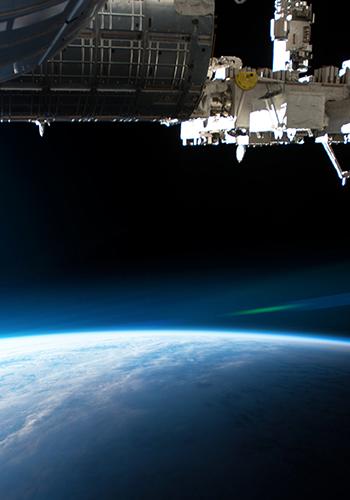Space-based Telecommunications

TILBA®-OGS optical ground stations enables very high-throughput space-based telecommunications networks
Satellite communication plays a pivotal role in global connectivity, connecting people and ideas. Today, space-based telecommunications services are essential to connect billions of people around the world, and this demand is constantly growing. However, current space-based telecommunications capabilities are limited by throughput, accessibility and security. Optical communications can offer a solution to these challenges.
Satellite communication systems rely on artificial satellites orbiting Earth to transmit communication signals (e.g. telephony, internet and secure communication), between different points on Earth. The infrastructure can be as large as a constellation, such as SpaceX’s Starlink internet network program or ESA’s HydRON program. These latest constellations, as well as those currently under construction, form a network or a mesh of satellites orbiting Earth that can communicate with each other before sending data back to Earth. This means that a ground station can communicate with a satellite located on the other side of the planet. This is referred to as inter-satellite communication. The benefits of this data transmission method include global coverage, resilience to natural disasters and ground-based network outages, and the ability to reach remote or hard-to-access areas.
Space-based telecommunication applications includes:
Satellite telephony: Conventional satellite telephony systems allow users to make phone calls from anywhere in the world, including in the most remote areas where ground-based networks are not available. In this case, a feeder link connects the isolated user to the ground-based telephone network via a telecom satellite and a ground station.
Satellite television: Similarly, satellite television systems make it possible to broadcast television programs to viewers throughout the world, even in the most remote locations that do not have the necessary infrastructure. The feeder link emitted by a ground station sends an uplink to the telecom satellite loaded with a large quantity of data that the satellite then redistributes in a multitude of signals to multiple destinations and end users. In mega constellations, the signal travels through the mesh of inter-satellite communication channels before reaching its destination.
Satellite internet: Satellite internet systems work in a similar way to TV, providing a high-throughput internet connection in areas where other conventional communication infrastructures are limited and costly. Programs such as Starlink and OneWeb have addressed the issue of internet connectivity, which has become an essential part of our society in areas such as health, education, security, the economy, and the corporate and public sectors.
Secure networks: Satellites play a crucial role in secure military communication and intelligence gathering by enabling communication with ground, air and naval stations. Military telecommunications satellites can be used to set up combat clouds, naval communication bubbles and secure networks for temporary deployment in military operations. This allows the deployment of temporary, secure and stealth connectivity solutions. Asynchronous data transfer helps create a secure communication channel for sovereign data exchange, especially between embassies.
Data centers: Satellites enable cloud operators to quickly integrate satellite data into their data centers, delivering faster, more efficient services to their customers. Satellites also reduce cloud service latency by providing optimal coverage via inter-communicating Low Earth Orbit (LEO) satellite networks.
Emergency communication: When traditional infrastructure is damaged or unavailable, e.g. in crisis situations or natural disasters, satellites can be used to establish emergency communications.
Offshore: Offshore platforms are isolated places without connectivity where deploying telecom infrastructure is particularly complex and cost ineffective.
Currently, radio frequency (RF) channels provide communication links for all of the above applications. However, radio frequency communication is now reaching capacity, which means that it can no longer meet the growing demand for connectivity in our society. One key limitation is the congestion of RF communication channels, which require a license to avoid inter-channel interference. Obtaining a license is increasingly difficult and involves significant expense and wait times. The C, KA and Ku bands are the most commonly used RF channels, while the X and L bands are primarily reserved for military and research applications. Furthermore, RF communication provides limited throughput and security: the effective bandwidth is a few hundred Mbps and reaches full capacity at just a few Gbps. In addition, the range of an RF signal covers the area of a small country, allowing anyone in the area to intercept the signal, which is convenient for public broadcasting but an issue for secure communication.
Free-space laser communication are emerging as a reliable communication solution that can meet the growing need for robust, accessible and secure very high-throughput networks. Optical satellite systems can provide space-to-ground and inter-satellite links. This technology relies on the propagation of light in a vacuum and in the air to exchange information. Faster, more secure, more compact and easier to deploy than current technologies, optical communication does not need a dedicated frequency band and the signals are difficult to intercept and jam. It also has the advantage of being compatible with ultra-high capacity ground-based telecom technologies (up to several Tb/s), allowing it to benefit from the technological maturity of the telecom industry.
Optical Inter Satellite Links (OISL) are already widely used within telecom, defense and Earth observation constellations. For example, SpaceX’s Starlink constellation uses optical inter-satellite communication technology. In Europe, Telesat plans to equip its Lightspeed constellation with OISL terminals by 2023, while in the U.S., OISL programs are being developed by the Space Development Agency (SDA) for its Tracking and Transport Layer military connectivity and surveillance constellations, and by the Defense Advanced Research Projects Agency (DARPA) for its Blackjack and Space-BACN programs.
Although optical communication has been used since the 1980s for its security and higher throughput rates, space telecom players have until now favored radio transmission technology for space-to-ground links due to historical constraints. On Earth, laser communication is limited by atmospheric turbulence. Disturbances caused by the heterogeneity and constant movement of air can affect the phase and intensity of the light beam, degrading the quality of the link as it passes through the earth’s atmosphere. However, a number of solutions exist to compensate for atmospheric turbulence.
Cailabs has developed a turnkey optical ground station based on its Multi-Plane Light Conversion (MPLC) technology, which can compensate for atmospheric turbulence and preserve transmission quality. TILBA®-OGS ground stations allows the implementation of very high-throughput space telecommunications networks:
- Optical communication at 10 Gbps and above, compliant with CCSDS and SDA standards
- TILBA®-ATMO and TILBA®-IBC technological building blocks embedded in the station enables increased range and robustness of laser communication in atmospheric turbulence
- Remotely operable and compatible with multiple missions
- Scalable to future Tb/s feeder link requirements with the coherent combination of TILBA®-CBC
The French Ministry of the Armed Forces, the AID (Agence de l’Innovation de Défense), the DGA (Direction Générale des Armées), the SSC (Swedish Space Corporation) as well as the company CONTEC trust and rely on Cailabs’ OGS.
References
- ESA article: HydRON is ESA’s vision for an end-to-end optical high throughput space network.
- Telesat article: Telesat Lightspeed™
- EDRS article: European Data Relay Satellite System (EDRS) Overview





